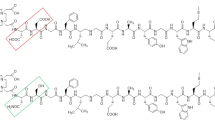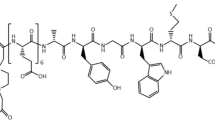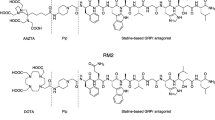Abstract
Purpose
Different attempts have been made to develop a suitable radioligand for targeting CCK-2 receptors in vivo, for staging of medullary thyroid carcinoma (MTC) and other receptor-expressing tumours. After initial successful clinical studies with [DTPA0,DGlu1]minigastrin (DTPA-MG0) radiolabelled with 111In and 90Y, our group developed a 99mTc-labelled radioligand, based on HYNIC-MG0. A major drawback observed with these derivatives is their high uptake by the kidneys. In this study we describe the preclinical evaluation of the optimised shortened peptide analogue, [HYNIC0,DGlu1,desGlu2–6]minigastrin (HYNIC-MG11).
Methods
99mTc labelling of HYNIC-MG11 was performed using tricine and EDDA as coligands. Stability experiments were carried out by reversed phase HPLC analysis in PBS, PBS/cysteine and plasma as well as rat liver and kidney homogenates. Receptor binding and cell uptake experiments were performed using AR4-2J rat pancreatic tumour cells. Animal biodistribution was studied in AR4-2J tumour-bearing nude mice.
Results
Radiolabelling was performed at high specific activities and radiochemical purity was >90%. 99mTc-EDDA-HYNIC-MG11 showed high affinity for the CCK-2 receptor and cell internalisation comparable to that of 99mTc-EDDA-HYNIC-MG0. Despite high stability in solution, a low metabolic stability in rat tissue homogenates was found. In a nude mouse tumour model, very low unspecific retention in most organs, rapid renal excretion with reduced renal retention and high tumour uptake were observed.
Conclusion
99mTc-EDDA-HYNIC-MG11 shows advantages over 99mTc-EDDA-HYNIC-MG0 in terms of lower kidney retention with unchanged uptake in tumours and CCK-2 receptor-positive tissue. However, the lower metabolic stability and impurities formed in the labelling process still leave room for further improvement.







Similar content being viewed by others
References
Kwekkeboom D, Krenning EP, de Jong M. Peptide receptor imaging and therapy. J Nucl Med 2000;41:1704–13.
Oberg K. Neuroendocrine gastrointestinal tumours. Ann Oncol 1996;7:453–63.
Reubi JC, Mäcke HR, Krenning EP. Candidates for peptide receptor radiotherapy today and in the future. J Nucl Med 2005;46:67S–75S.
de Jong M, Bakker WH, Bernard BF, Valkema R, Kwekkeboom DJ, Reubi JC, et al. Preclinical and initial clinical evaluation of 111In-labeled nonsulfated CCK8 analog: a peptide for CCK-B receptor-targeted scintigraphy and radionuclide therapy. J Nucl Med 1999;40:2081–7.
Behr TM, Jenner N, Radetzky S, Behe M, Gratz S, Yucekent S, et al. Targeting of cholecystokinin-B/gastrin receptors in vivo: preclinical and initial clinical evaluation of the diagnostic and therapeutic potential of radiolabelled gastrin. Eur J Nucl Med 1998;25:424–30.
Behr TM, Jenner N, Behe M, Angerstein C, Gratz S, Raue F, et al. Radiolabeled peptides for targeting cholecystokinin-B/gastrin receptor-expressing tumors. J Nucl Med 1999;40:1029–44.
Aloj L, Panico MR, Caraco C, Zannetti A, Del Vecchio S, Di Nuzzo C, et al. Radiolabeling approaches for cholecystokinin B receptor imaging. Biopolymers 2002;66:370–80.
Behe M, Becker W, Gotthardt M, Angerstein C, Behr TM. Improved kinetic stability of DTPA-DGlu as compared with conventional monofunctional DTPA in chelating indium and yttrium: preclinical and initial clinical evaluation of radiometal labelled minigastrin derivatives. Eur J Nucl Med Mol Imaging 2003;30:1140–6.
Laverman P, Behe M, Oyen WJ, Willems PH, Corstens FH, Behr TM, et al. Two technetium-99m-labeled cholecystokinin-8 (CCK8) peptides for scintigraphic imaging of CCK receptors. Bioconjug Chem 2004;15:561–8.
Nock BA, Maina T, Behe M, Nikolopoulou A, Gotthardt M, Schmitt JS, et al. CCK-2/gastrin receptor-targeted tumor imaging with 99mTc-labeled minigastrin analogs. J Nucl Med 2005;46:1727–36.
Behr TM, Behe MP. Cholecystokinin-B/gastrin receptor-targeting peptides for staging and therapy of medullary thyroid cancer and other cholecystokinin-B receptor expressing malignancies. Semin Nucl Med 2002;32:97–109.
Gotthardt M, Behe MP, Alfke H, Behr TM. Imaging lung tumors with peptide-based radioligands. Clin Lung Cancer 2003;5:119–24.
Gotthart M, Grass J, Schipper ML, Höffken H, Schlieck A, Schurrat T, et al. Scintigraphy with In-111-DTPA-D-Glu1-minigastrin and In-111-DTPA-D-Phe1-octreotide in patients with gastrointestinal neuroendocrine tumors: results of the first 60 patients. Eur J Nucl Med Mol Imaging 2003;30:S181.
Reubi JC, Schaer JC, Waser B. Cholecystokinin (CCK)-A and CCK-B/gastrin receptors in human tumors. Cancer Res 1997;57:1377–86.
Reubi JC, Korner M, Waser B, Mazzucchelli L, Guillou L. High expression of peptide receptors as a novel target in gastrointestinal stromal tumours. Eur J Nucl Med Mol Imaging 2004;31:803–10.
von Guggenberg E, Behe M, Behr TM, Saurer M, Seppi T, Decristoforo C. 99mTc-labelling and in vitro and in vivo evaluation of HYNIC- and \( {\left( {N_{\alpha } - His} \right)} \)acetic acic-modified [D-Glu1]-minigastrin. Bioconjug Chem 2004;15:864–71.
Behe M, Behr TM. Cholecystokinin-B (CCK-B)/gastrin receptor targeting peptides for staging and therapy of medullary thyroid cancer and other CCK-B receptor expressing malignancies. Biopolymers 2002;66:399–418.
Behe M, Kluge G, Becker W, Gotthardt M, Behr TM. Use of polyglutamic acids to reduce uptake of radiometal-labeled minigastrin in the kidneys. J Nucl Med 2005;46:1012–5.
Béhé M, de Jong M, Reubi JC, Nock B, Schmitt JS, Maecke H, et al. Optimising of In-111 labelled minigastrin related to the kidney uptake. Eur J Nucl Med Mol Imaging 2003;30:S199.
Decristoforo C, Melendez-Alafort L, Sosabowski JK, Mather SJ. 99mTc-HYNIC-[Tyr3]-octreotide for imaging somatostatin-receptor-positive tumors: preclinical evaluation and comparison with 111In-octreotide. J Nucl Med 2000;41:1114–9.
von Guggenberg E, Sarg B, Lindner H, Melendez Alafort L, Mather SJ, Moncayo R, et al. Preparation via coligand exchange and characterization of [99mTc-EDDA-HYNIC-D-Phe1,Tyr3]octreotide (99mTc-EDDA/HYNIC-TOC). J Lab Compd Radiopharm 2003;46:307–18.
Breeman WAP, de Blois E, van Gameren A, Melis M, Fröberg A, de Jong M, et al. Aspects of CCK-2 Receptor-Targeting with 111In-DOTA-MG. In: Mazzi U, editor. Technetium, rhenium and other materials in chemistry and nuclear medicine 7. Padova: SG Editoriali; 2006. p 231–2.
Behe M, Reubi J, Nock B, Mäcke H, Breeman WAP, Bernard HF, et al. Evaluation of a DOTA-minigastrin derivative for therapy and diagnosis for CCK-2 receptor positive tumours. Eur J Nucl Med Mol Imaging 2005;32:S78.
Acknowledgments
The authors want to thank all the members of the COST Action B12: “Radiotracers for In Vivo Assessment of Biological Function”, WG-3: “Radiolabeled Biologically Active Peptides” for fruitful discussions. We specifically thank Mr. Stephan Schwarz for his skilled technical assistance, Ms. Maria Saurer for her support in the cell culture and Prof. Georg Riccabona for his critical review of the manuscript.
Author information
Authors and Affiliations
Corresponding author
Additional information
Parts of this study were presented at the Annual Congress of the European Association of Nuclear Medicine, Istanbul, Turkey, October 2005 and at the 7th International Symposium on Technetium in Chemistry and Nuclear Medicine, Bressanone, Italy, September 2006.
Rights and permissions
About this article
Cite this article
von Guggenberg, E., Dietrich, H., Skvortsova, I. et al. 99mTc-labelled HYNIC-minigastrin with reduced kidney uptake for targeting of CCK-2 receptor-positive tumours. Eur J Nucl Med Mol Imaging 34, 1209–1218 (2007). https://doi.org/10.1007/s00259-006-0348-3
Received:
Accepted:
Published:
Issue Date:
DOI: https://doi.org/10.1007/s00259-006-0348-3




